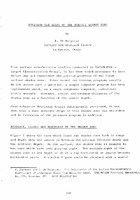| dc.description.abstract | From surface reverberation studies conducted by SACLANTCEN's Target Classification Group"C , it has been found necessary to know before any sea experiment the precise position of the first surface shadow zone. Since normal ray tracing programs usually do not answer such a question, a simple computer program has been implemented which, on a small shipborne computer, calculates within seconds: distance, extent and maximum thickness of the shadow zone as a function of the source depth. From submarine detection trials subsequently performed, it was seen that a more accurate shape of this shadow zone was desirable and an extension of the previous program is underway. | |
